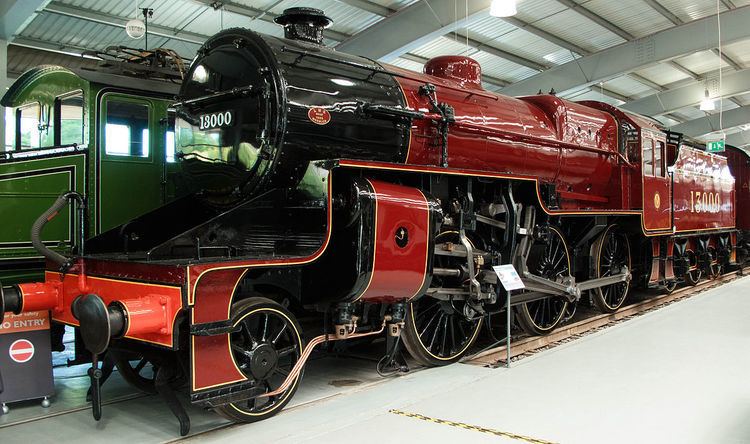Power type Steam Build date 1926–1932 | Total produced 245 | |
 | ||
The London Midland and Scottish Railway (LMS) Hughes Crab or Horwich Mogul is a class of mixed traffic 2-6-0 steam locomotive built between 1926 and 1932. They are noted for their appearance with large highly-angled cylinders to accommodate a restricted loading gauge.
Contents
Nicknames
These locomotives were referred to as "Crabs". Several authors have claimed that this refers to the resemblance to a crab's pincers of the outside cylinders and valve motion. Another suggestion is that the nickname refers to the "scuttling" motion felt on the footplate when the engine is being worked hard, due largely to the inclined cylinders, producing a sensation that it is walking along the track. In some areas they also received the nickname "frothblowers" from their tendency to prime easily when the boiler was overfilled, or the feedwater contaminated.
Overview
Designed by George Hughes, Chief Mechanical Engineer of the LMS, and built at the ex-L&YR works at Horwich and the ex-LNWR works at Crewe, they were put into service by his successor, Henry Fowler. The design incorporated a number of advanced features for the time such as long travel valves, compensated brake gear, a new design of tender and a new boiler, the latter based on the one fitted to Hughes' four-cylinder Baltic tank locomotives built at Horwich.
Fowler tried to have the design altered to use standard Derby components. However the design process and pre-production were sufficiently advanced to prevent the fitting of a smaller Derby pattern boiler, and the cylinders and motion also remained as designed by Hughes. The tender was replaced by a Derby standard type, which was narrower than the cab. Standard Midland Railway boiler fittings and brake equipment were also substituted, and the class became something of a hybrid design. Nevertheless they performed rather well in most circumstances and gained a strong reputation in some areas, especially in Scotland, where they became the preferred locomotive for heavy unfitted mineral work on difficult routes, even after the introduction of the Stanier mixed traffic 4-6-0s.
Accidents and incidents
Numbering
Initially numbered 13000–244, as standard locomotives they were given the lower numbers 2700–2944 in the LMS 1933 renumbering scheme. After being taken into British Railways stock an additional 40000 was added to their numbers, becoming 42700–42944.
Experiments
In 1931 five engines, 13118, 13122, 13124, 13125 and 13129 were fitted with Lentz valve gear. They were renumbered as 42818, 42822, 42824, 42825 and 42829 after nationalisation. In 1953 the Lentz valve gear on these engines was replaced with Reidinger valve gear.
LMS Stanier Mogul
When an order was placed by the traffic department for delivery of 40 more examples of this type, the new Chief Mechanical Engineer, William Stanier, decided to introduce a taper boiler version, in line with his policy of using taper boilers on all new locomotive designs. There were so many changes to the layout of the locomotive, such as higher boiler pressure and smaller cylinders, that it became a new design, the LMS Stanier Mogul.
Withdrawal
The class survived intact until 1961 when three were withdrawn. The remainder of the class were withdrawn over the next six years.
Survivors
Three have survived, 13000/2700/42700, 13065/2765/42765 and 13159/2859/42859
13000/2700/42700
The first-built locomotive was built at Horwich, 2700 is part of the National Railway Collection and currently on static display at the National Railway Museum in York.
13065/2765/42765
42765 has been restored to working order on the East Lancs Railway and, following a further heavy overhaul, returned to service in 2014 in Crimson Lake Livery numbered 13065 (the number the engine had on registration). This makes the East Lancashire Railway's "Crab" the last working steam engine of its kind. In January 2016, 13065 operated with Flying Scotsman: due to the extensive repairs to Flying Scotsman, it needed to be weaned into full operation and relied on several steam and diesel engines including 13065 to accompany it for health and safety reasons (including Passenger safety).
13159/2859/42859
No. 42859 had been stored at RAF Binbrook in a dismantled state since 1995 whilst the owner undertook its restoration.
However, in November 2012, after the driving wheels and tender frame were removed without the owner's permission, an injunction was obtained to prevent any further removal of parts. The driving wheels were later discovered by the police during a raid of a nearby industrial unit in an unrelated operation; the owner of the premises was served with a notice preventing the wheels' removal. In June 2013, it was announced that the matter had been classified as a civil dispute by Lincolnshire Police and will have to be pursued through the courts. The boiler and frames were removed from storage in Binbrook under police supervision and moved to a secret location. Legal proceedings for the return of the wheels and tender frame are underway. The boiler was subsequently cut up in a Nottingham scrapyard having been sold by the owner to pay for the costs of moving it from Binbrook. The owner stated that the boiler was beyond economic repair and that he has retained sufficient parts to allow a replacement to be built. The wheels remain at RAF Binbrook under a court order.
Models
Models exist in 00 gauge. An old and rather inaccurate model was produced by Lima, and an updated model has since been produced by Bachmann. N gauge models are produced by Graham Farish.
